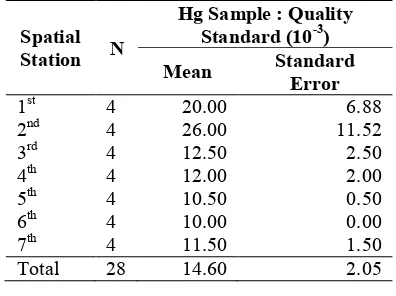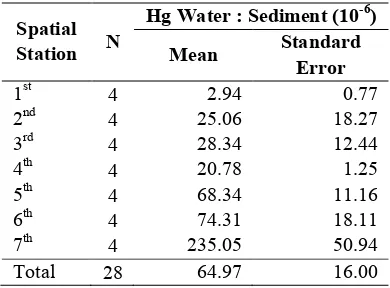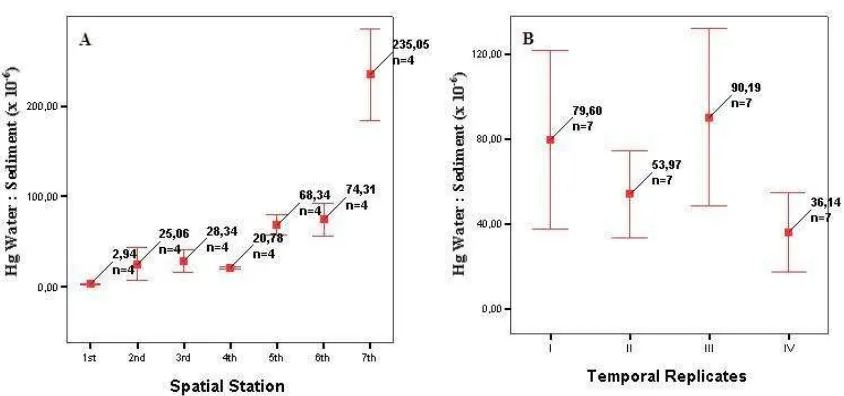ISSN: 2339-076X, Volume 2, Number 3 (April 2015): 335-340
DOI:10.15243/jdmlm.2015.023.335
Research Article
Pollution status and mercury sedimentation in small river near
amalgamation and cyanidation units of Talawaan-Tatelu gold mining,
North Sulawesi
T. M. Palapa
*, A.A. Maramis
Department of Biology, Faculty of Mathematics and Natural Sciences, State University of Manado (UNIMA), Minahasa, North Sulawesi, 95618, Indonesia
* corresponding author: [email protected]
Abstract
:The activities of traditional gold mining in the region of Talawaan-Tatelu, North Minahasa regency, North Sulawesi, have been ongoing since 1998. Processing the gold in the mine consists of three stages i.e., the excavation, milling and amalgamation, and the use of cyanide tanks. Waste from the processing units which contains high mercury, generally flows directly into small rivers nearby. This study aimed to determine the pollution status and mercury sedimentation in a small river near the amalgamation and cyanidation processing units in Talawaan-Tatelu gold mining. Water and sediment samples were taken from seven stations along a small river, as many as four temporal replications (weekly). Mercury determination in water and sediments was done by using Cold Vapor Atomic Fluorescence Spectrometry. Pollution status was determined through the calculation of Hg ratio in water samples and in water quality criterion (4thclass, as noted in The Indonesian Government Regulation No. 82 of 2001 on Water Quality and Water Pollution Control), while the mercury sedimentation was calculated from the ratio of mercury in water and sediment. The results showed that there are differences in the status of pollution and mercury sedimentation of seven sampling stations. Amalgamation and cyanidation processing units provide significant impact on the status of pollution (although it is categorized in contamination) and mercury sedimentation along small river in the gold mining area of Talawaan-Tatelu. The downstream of this small river, Talawaan River, is the main river of the Talawaan watershed. Things that should be a concern are Talawaan rural communities living near Talawaan River who often use the water for daily needs such as bathing and washing. Risk to public health around the river can arise when the status of pollution and mercury sedimentation are influenced by the amalgamation and cyanidation processing units.Keywords:amalgamation, cyanidation, gold mining, mercury sedimentation
Introduction
In North Minahasa Regency, North Sulawesi Province, Indonesia, there is an artisanal and small-scale gold mining (ASGM) which has been in operation since 1998, located precisely in the village Talawaan and Tatelu. Talawaan-Tatelu gold mining was originally operated by an Australian mining company, Aurora Mining Co.
(herein is known as Archipelago Resources Pty. Ltd.). Furthermore, the mining concessions changed hands on indigenous people (Veiga et al., 2009). In gold processing, the miners initially use amalgamation technique, which involves the
watershed (Lasut and Yasuda, 2009). Many rural communities are settled along the riverbanks of Talawaan River. The communities often use the water for daily purposes (such as for bathing and washing) and support of economic activities (such as for farming activities, irrigating paddy fields, including freshwater fishponds) (Lasut and Yasuda, 2009; Malik et al., 2010). In these circumstances, there should be monitoring of mercury content in river water. Some mercury monitoring data have been reported by several researchers (Keith, 1991; McGeer et al., 2003; Filho et al., 2004; Palapa and Maramis, 2014a), but they are not conducted in a sustainable manner (the last monitoring data was reported about 12 years ago). Therefore, the purpose of this study was to determine the pollution status and sedimentation of mercury in a small river near the amalgamation and cyanidation unit in Talawaan-Tatelu gold mining.
Methods
Research design
This study used a randomized block design in which independent variables were the spatial and temporal factors. Spatial factors consisted of seven groups of sampling stations, where each group was taken four times as temporal replicates with a span of four days. The dependent variables in this study were the pollution status (determined through
calculation of the ratio of Hg in water samples, and water quality criterion (4th class, as noted in The Indonesian Government Regulation No. 82 of 2001 on Water Quality and Water Pollution Control) (Singgih, 2007) and mercury sedimentation (determined through calculation of the ratio of Hg in water and sediment). The location of seven sampling sites can be seen in Figure 1. Samples of water, sediment, and plants were taken by judgmental sampling (Krisnayanti et al., 2012). Description of the location of seven stations for judgmental sampling consideration are presented below:
• 1st station: upstream of small river, 6 units of amalgamation and cyanidation in radius of 500 m;
• 2nd station: downstream side of 1st station (13.5 m), 3 units of amalgamation in radius of 25 m;
• 3rd station: downstream side of 2nd station (14.6 m);
• 4th station: downstream side of 3rd station (40 m);
• 5th station: downstream side of 4th station (450 m), 1 unit of cyanidation in radius of 100 m;
• 6th station: downstream side of 5th station (1 km); and
• 7th station: downstream side of 6th station (250 m).
Mercury determination and data analysis
Determinations of mercury in water and sediment were carried out by a testing laboratory, Water Laboratory Nusantara (WLN, PT. Water Laboratory Nusantara Indonesian, www.wln.co.id). This laboratory has been accredited as a testing laboratory by the National Accreditation Committee (KAN) with registration number: LP-433-IDN. The determination of mercury (Hg) dissolved in water samples was used Cold Vapor Atomic Fluorescence Spectrometry (CVAFS, USEPA-245.7, 2005) method, while that in sediments was used the reference method modified by the Water Laboratory Nusantara (WLN-ML-WI -01). The data of pollution status and sedimentation of mercury were analyzed by
using non-parametric statistics (Friedman test, α 5%) (Sehmel, 1989).
Results and Discussion
Pollution status of mercury
Data of pollution status calculated by using the ratio of mercury in water sample and quality standard criterion (4thclass, as noted in The Indonesian Government Regulation No. 82 of 2001 on Water Quality and Water Pollution Control) based on spatial station categories are presented in Figure 2A and Table 1, while those based on temporal replicates categories are presented in Figure 2B and Table 2.
Figure 2. Dot graph of the mean of Hg ratio in samples and quality standard (4thClass, as noted in The Indonesian Government Regulation No. 82 of 2001 on Water Quality and Water Pollution Control) based on: (A) spatial station of small river near amalgamation and cyanidation unit in Talawaan-Tatelu gold mining; and (B) temporal replicates, with a span of four days.
Table 1. The mean of ratio of mercury in samples and quality standard (IV Class) based on spatial station
Spatial
Station N
Hg Sample : Quality Standard (10-3)
Mean Standard
Error
1st 4 20.00 6.88
2nd 4 26.00 11.52
3rd 4 12.50 2.50
4th 4 12.00 2.00
5th 4 10.50 0.50
6th 4 10.00 0.00
7th 4 11.50 1.50
Total 28 14.60 2.05
contamination, mercury pollution status tended to show a decline from the station located in the upstream to downstream.
Table 2. The mean of ratio of mercury in samples and quality standard (IV class) based on temporal replicates
Temporal
Replicates N
Hg Sample : Quality Standard (10-3)
Total 28 14.60 2.05
Mercury sedimentation
Data of mercury sedimentation calculated by using the ratio of mercury in water and sediment based on spatial station categories are presented in Figure 3A and Table 3, while those based on temporal replicates categories are presented in Figure 4B and Table 4. The results of calculation of mercury sedimentation showed that the sedimentation tended to incline from the station located in the upstream to downstream. The mercury contamination of seven stations in a small river system flowing near the amalgamation and cyanidation units showed a declining trend from upstream to downstream.
Table 3. The Mean of ratio of mercury in water and sediment based on spatial station
Spatial
Total 28 64.97 16.00
Table 4. The mean of ratio of mercury in water and sediment based on temporal replicates
Temporal
Replicates N
Hg Water : Sediment (10-6)
Mean Standard
Error
I 7 79.60 42.20
II 7 53.97 20.67
III 7 90.19 41.87
IV 7 36.14 18.59
Total 28 64.97 16.00
The difference of mercury contamination between stations is reinforced by the results of the Friedman test (Tables 5 and 6) show P value less thanα(5%).
Table 5. The mean rank of mercury ratio in sample and quality standard, and in water and sediment based on sampling station
Spatial
Figure 3.Dot graph of the mean of Hg ratio in water and sediment based on: (A) spatial station of small river near amalgamation and cyanidation unit in Talawaan-Tatelu gold mining; and (B) temporal replicates, with a span of four days.
Friedman test (α 5%) results for mercury sedimentation showed a tendency that the rate of precipitation of mercury from water to sediment increased from upstream to downstream. Mercury from direct discharges or underground seepage of tailings water formed a bond with the organic particles in the water of river. A certain proportion of these bonds due to gravity experienced precipitation to the bottom of river.
Conclusion
Amalgamation and cyanidation processing units provide significant impact on the status of pollution (although it is categorized in contamination) and mercury sedimentation along a small river in the gold mining area of Talawaan-Tatelu. The downstream of this small river, Talawaan River, is the main river of Talawaan watershed. Things should be a concern that Talawaan rural communities living near Talawaan River often use the water for daily needs such as bathing and washing. Risks to public health around the river can arise given the status of pollution and mercury sedimentation are influenced by the amalgamation and cyanidation processing units.
Acknowledgement
This work was supported in part by the Directorate General of Higher Education, Ministry of Education and Culture under National Strategic Grant
0525/E5.2/PL/2012. The authors thank the Organizing Committee of the International Conference of Environmental Pollution on Human Health (February 14-15, 2015, Malang Islamic University, Indonesia), for correcting this manuscript.
References
Filho, S.R.P., dos Santos, R.L.C., Bôas, R.C.V., Castilhos, Z.C., Yallouz, A.V., Peregovich, B., Pereira, D.M., Nascimento, F.M.F., Pedroso, L.R.M., Bose-O’Reilly, S., Drasch, G., Dittman, A., Illig, S., Maydl, S. and Lettmeier, B. 2004. Vienna: United Nations Industrial Development Organization. Industrial Development Report 2004 United Nations Industrial Development Organization Vienna, 2004
Keith, L.H. 1991. Environmental Sampling and Analysis – A Practical Guide”. CRC Press LLC, 1991, p16. Krisnayanti, B.D., Anderson, C.W.N., Utomo, W.H.,
Feng, X., Handayanto, E., Mudarisna, N., Ikram, H. and Khususiah. 2012. Assessment of environmental mercury discharge at a four-year-old artisanal gold mining area on Lombok Island, Indonesia.Journal of Environmental Monitoring14 (10): 2598-2607 Lasut, M.T. and Yasuda, Y. 2009. Potential
contamination of mercury from artisanal gold mining in the Talawaan watershed area, north Sulawesi, Indonesia. Proceedings of NIMD Forum 2009, 19-20 February 2009. Conference Hall, Minamata Disease Archives, National Institute for Minamata Disease, Minamata City, Kumamoto, Japan.
north Sulawesi, Indonesia.Otsuchi Marine Science
28: 99-101.
Malik, R.N., Husain, S.Z. and Nazir, I. 2010. Heavy metal contamination and accumulation in soil and wild plant species from industrial area of Islamabad, Pakistan.Pakistan Journal of Botany42:291-301. McGeer, J.C., Brix, K.V., Skeaff, J.M., DeForest, D.K.,
Brigham, S.I., Adams, W.J. and Green, A. 2003. Inverse relationship between bioconcentration factor and exposure concentration for metals: Implications for hazard assessment of metals in the aquatic environment. Environmental Toxicology and Chemistry 22 (5): 1017-1037.
Palapa, T.M. and Maramis, A.A. 2014a. Content of Metals in Water and Sediment of Talawaan Gold Mine Tailings Amalgamation. Proceedings of the National Seminar on Science and Science Education IX, Faculty of Science and Mathematics UKSW Salatiga, June 21, 2014, Vol 5, 1, p. 586-593 (in Indonesian).
Palapa, T.M. and Maramis, A.A. 2014b. Monitoring Tatelu Talawaan Mine through field observations, satellite imagery, and GIS. Proceedings of the National Seminar on Science and Science Education IX, Faculty of Science and Mathematics UKSW Salatiga, June 21, 2014, Vol 5, 1, p. 594-601 (in Indonesian).
Santoso, S. 2007. Mastering of Statistics in the Information Era with SPSS 15. Jakarta: PT Elex Media Komputindo Gramedia (in Indonesian). Sehmel, G.A. 1989. Cyanide and Antimony
Thermodynamic Database for the Aqueous Species and Solids for the EPA-MINTEQ Geochemical Code. Pacific Northwest Laboratory Operated for the U.S. Department of Energy by Battelle Memorial Institute . Richland, Washington



